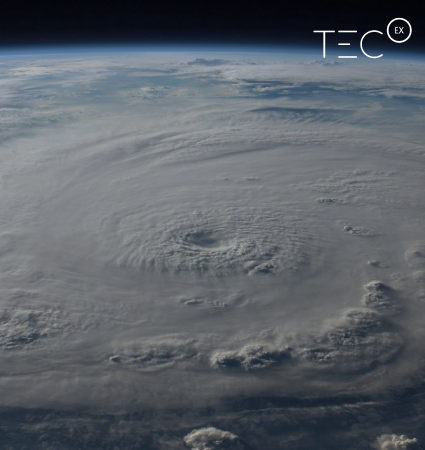Supply Chain Risk Management (SCRM) is vital to smooth global operations. Every individual link in the chain can make or break your success, and having a global supply chain brings a world of potential risks and disruptions.
Operational resilience is pertinent whether warfare, typhoons, unpredictable demand, supply shortages, trade wars, or cyberattacks threaten your supply chain. Companies must actively identify and mitigate possible risks to avoid substantial financial and reputational losses.
What Is Supply Chain Risk Management?
In short, Supply Chain Risk Management is the assessment and monitoring of risks to minimize business disruption with strategies to mitigate the identified threats.
Supply chain risks can be internal or external and are not always avoidable. The main categories of risks include:

Catastrophic Risks | SCRM
Extreme weather and natural disasters can cause significant disruptions. Super Typhoon Kong-rey, which threatened landfall for days before its eventual peak on Thursday, October 31st, shows how disruptive natural disasters can be for supply chains. Ports in Taiwan, Japan, The Philippines, China, and South Korea were threatened for days, waiting with bated breath as they anticipated manufacturing and shipping sectors to be impacted by delays, congestion, and shipment rerouting.

Geopolitical Risks | SCRM
Geopolitical risks range from political instability to trade regulations. These uncontrollable events have the power to reshape supply chains, and global shippers must constantly adapt to work around them.
Earlier this year, the ongoing political instability in the Middle East had halted shipping through the Red Sea, forcing shippers to forge new routes. The US-China trade war, which resulted in US export regulations on AI chips to China, highlights the impact of trade wars and sanctions on shipping high-tech goods. The EU’s recent tariffs on Chinese electric vehicles have brought a looming threat of an EU-China trade war.
Repercussions of Blocked Trade Routes
Remember the Suez Canal blockage in March 2021? When the significant maritime choke point was blocked, major supply chain disruptions followed over the 7 days the Ever Given container ship blocked the canal. Supply chain disruptions to over 400 vessels accumulated costs between $15 and $17 billion.

Financial Risks | SCRM
Fluctuating exchange rates can cause financial losses as you may become obligated to pay more than you originally bargained for. Other issues like cost increases, inability to access credit, inflation, or even bankruptcy of an involved company can affect your supply chain.
De-Dollarization
Several countries, especially the BRICS alliance (Brazil, Russia, India, China, and South Africa), are pushing to adopt alternative currencies for trade settlement in response to the constant threat of US sanctions. This has led them to develop new payment methods and to use their currencies over the dollar in trade transactions.

Supply Risks | SCRM
When goods or services become unavailable, supply disruptions arise. Suppliers can halt the supply chain with financial instability, capacity constraints, new owners, and bankruptcy. Unavailable items can lead to delayed workflows, order backlogs, rising prices, and widespread shortages.

Demand Risks | SCRM
Predicting product demand is challenging when consumer preferences and alternatives constantly evolve. Change is the only certainty in supply chains today. Poor predictions can cause inventory over- and under-stocking, leading to plummeting profitability and rising customer dissatisfaction.
Demand Forecasting
Demand forecasting plays a massive role in avoiding demand-related risks. Essentially, this involves estimating the future demand for your products. From supply chain delays to seasonality, you need to be aware of the many factors that affect demand. Over 2023’s Black Friday and Cyber Monday (BFCM) weekend, Shopify sales grew 24% from 2022’s BFCM – reaching a record $9.3B in sales. Merchants couldn’t have reached these heights without forecasting their product demand over this period in advance.
If you need an e-commerce shipping solution to optimize inventory levels and satisfy your customers, TecEx can help.

Ethical and Social Risks | SCRM
All parties throughout the supply chain must be assessed to identify and avoid unethical practices, such as human rights abuses, labor violations, and damaging environmental impacts. An unethical supply chain can result in substantial costs and reputational damage. Geopolitical tension further complicates this. While certain regions attempt to enforce climate change initiatives requiring a coordinated global effort, this will likely cause more global division.

Cybersecurity Risks | SCRM
Today’s digital systems are vulnerable to cyberattacks. These can result in disasters like data breaches, ransomware, and loss of intellectual property, leading to reputational damage, financial losses, and lawsuits.

Operational Risks | SCRM
Human errors, inefficient workflows, and system failures can disrupt internal processes and affect the supply chain. Inaccurate forecasting and assessments, as well as poorly planned production and management, can threaten all aspects of a healthy supply chain. Unintended violations of compliance and obligations (as defined by Incoterms) can cause significant disruptions.
Challenges of Supply Chain Risk Management
Globalization allows your products to reach broader markets at the cost of complex supply chains. Because of this, it’s challenging to keep track of every detail of a supply chain.
A company needs reliable data on its suppliers to assess supply chain risks, but many suppliers want to protect their privacy and are unwilling to provide this data. Once a risk has been identified in relation to a supplier, this does not guarantee that they will be willing to change their practices to mitigate these risks. This makes a compelling case for central procurement through a trusted centralized vendor rather than buying locally.
Lastly, new technologies to assist with SCRM, staff training, and constant monitoring may be too costly for some businesses

TecEx can reduce these unavoidable shipping challenges by taking on your risk. We have in-depth knowledge to help you build more resilient and adaptable supply chains. We offer end-to-end liability cover. We know unforeseen events happen, so your shipment will be covered for damage, loss, or theft. We cover your shipment from the factory to the final destination or warehouse, whether the movement is international or domestic.
Why Is Supply Chain Risk Management Important?

SCRM is essential for any global or domestic shipments. By preparing for unexpected events, proactively maintaining operations, and meeting customer demand, you also improve your supply chain resilience and ensure business continuity. SCRM reduces your exposure to risks regarding quality, reliability, and reputability.
Continuously eliminating inefficiencies and reducing waste also reduces costs. Predicting customer demand accurately and optimizing inventory levels enables more flexibility and adaptability while ensuring customer satisfaction with faster order fulfillment.
Staying on top of compliance and trade regulations while safely navigating geopolitical tensions and instability will prevent delayed arrivals, stuck shipments, additional costs like demurrage, confiscated goods, and jail time.
Ensure your suppliers meet quality and regulatory requirements to avoid recalls and legal penalties. This protects your reputation and ensures your customers receive high-quality goods. It can also help your business support sustainable practices and limit your environmental impact while contributing to achieving environmental, social, and governance (ESG) goals.
You’ll reap many rewards with efficient Supply Chain Risk Management, including increased stakeholder confidence, a stronger competitive advantage, and better regulatory compliance.
How Can TecEx Improve Your SCRM?
IOR and EOR Services
With TecEx as your Importer of Record (IOR) or Exporter of Record (EOR), we will ensure compliance with trade regulations, prepare all necessary documentation, and guarantee seamless customs clearance.
Our expert understanding of global events means we can ensure your shipments successfully circumnavigate natural disasters and political instability while complying with ever-changing sanctions and tariffs.
With reverse logistics and RMA specialists, we can improve your waste reduction efforts by making it easier to return and repair your tech goods. Our RMA management offers to minimize your costs and ensure compliance while moving your goods back through the supply chain, which not only increases customer satisfaction but also contributes to a circular economy.
With TecEx, you can streamline import and export processes, reduce overall risk exposure, and facilitate smoother cross-border transactions. Our specialized IOR EOR services will enhance your supply chain efficiency and supply chain risk management.
Warehousing Solution
With TecEx’s warehousing solution, you can keep up with fluctuating customer demand. Our warehousing network across the United States, the Netherlands, and the United Kingdom can help you scale your business operations and improve your supply chain with flexible storage options.
With our Forward Stocking Locations strategically positioned close to key markets, we can enable rapid goods deployment while reducing costs, improving flexibility, and mitigating supply chain risks caused by shortages, delays, and global events.
Centralized Procurement
TecEx can assist you with a streamlined central procurement solution wherever you are in the supply chain. Centralized procurement decision-making can save costs and decrease lead times while ensuring company-wide procurement compliance and less risk to the business.
A central procurement approach also improves supply chain visibility, allowing companies to carry out their due diligence on suppliers. This enhanced transparency helps brands safeguard their reputation with better quality, fewer supply disruptions, and contributions to ESG initiatives.
Liability Cover For Unavoidable Risks
What about the risks that you can’t prevent? We offer end-to-end liability cover for shipments to over 200 destinations traveling via road, rail, sea, or air. With TecEx liability cover, your total replacement value is covered from pick-up to the final delivery.
As an IOR or freight solution client, we can cover your shipments up to and exceeding $30 million. Whether you need to cover multiple or ad hoc shipments, new or used items, high-value tech or dual-use goods, TecEx has you covered.
The TecEx App
Efficient technology goes hand-in-hand with effective Supply Chain Risk Management. Our app enables transparent, live shipment tracking and management. You can benefit even more from the app by adding your third-party suppliers to the shipment management process. This encourages open communication, collaboration, and trust for stronger supplier relationships and a more robust supply chain.

Ready To Improve Your Supply Chain Risk Management?
Contact TecEx today to learn how we can take supply chain risk off your shoulders and optimize your risk management.
FAQs
What Is SCRM?
Supply Chain Risk Management is the process of identifying, assessing, mitigating, and monitoring risks within a supply chain. The goal is to minimize disruptions and ensure business continuity.
What Are Common Risks In Supply Chains?
Common risks include natural disasters, supplier failures, geopolitical issues, transportation delays, cybersecurity threats, and compliance problems. Each can significantly impact operations and requires proactive mitigation strategies.
Can SCRM Improve My Competitive Advantage?
Yes, effective Supply Chain Risk Management can ensure timely deliveries, reduce costs associated with disruptions, and provide a more resilient operational framework, thus improving your competitive edge and growing your customers’ trust.
What Steps Can I Take To Mitigate Supply Chain Risks?
Risk management in supply chain management involves diversifying suppliers, increasing inventory levels, real-time tracking of goods, developing contingency plans, understanding compliance and trade requirements, avoiding warzones and natural disasters, and building strong relationships with your partners.

